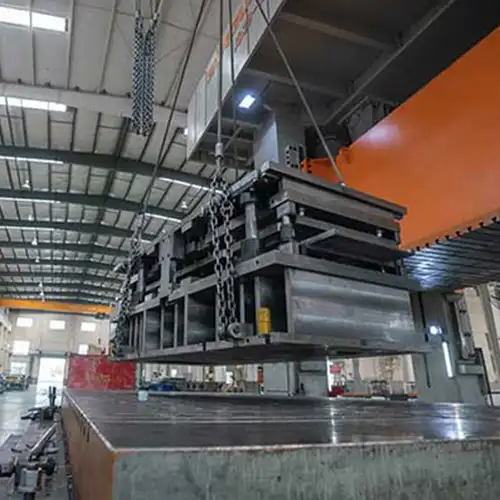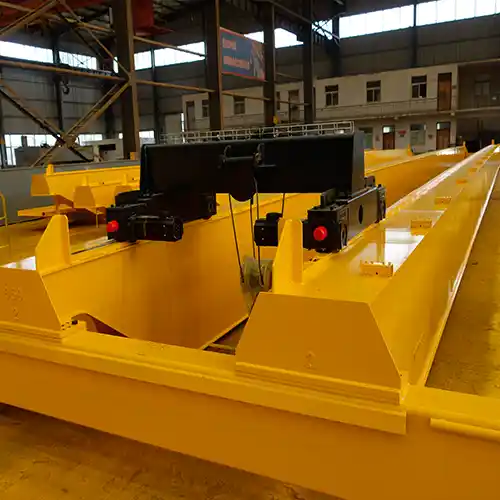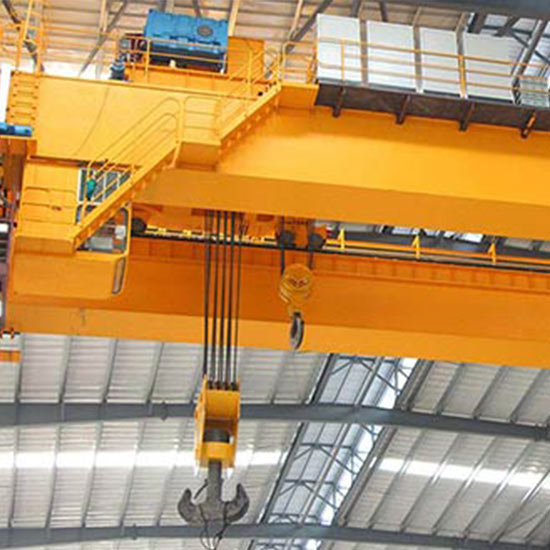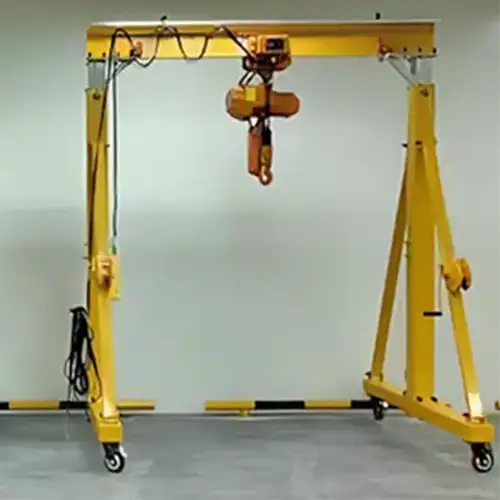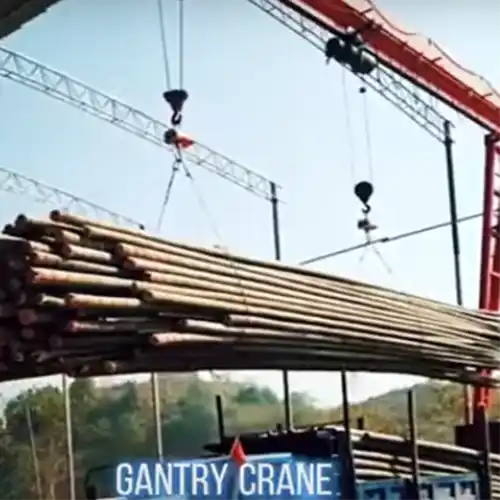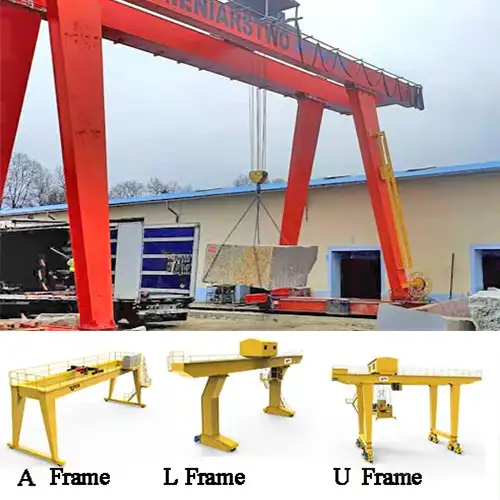UK Auto Industry's Guide to Efficient Overhead Crane Operations 3 to 80 Ton
Explore overhead cranes 5 to 80 Ton in the UK automobile industry, including types, applications, benefits & key considerations for efficient operations.
Category: United Kingdom
Your Trusted Overhead Crane Manufacturer & Supplier
UK Auto Industry's Guide to Efficient Overhead Crane Operations
Overhead Cranes 5 to 80 Ton in UK Auto-industry, Types & Applications
UK Auto Industry's Guide to Efficient Overhead Crane Operations
Explore overhead cranes 5 to 80 Ton in the UK automobile industry, including types, applications, benefits & key considerations for efficient operations.
Overview of the UK Automobile Industry
The UK automobile industry has a rich history, evolving from early 20th-century manufacturing to become a significant player in the global automotive market. Initially focused on craftsmanship and small-scale production, the industry grew rapidly post-World War II, driven by innovations in technology and increased demand for vehicles. Today, the sector is renowned for its advanced engineering, design capabilities, and high-quality production.
Currently, the UK automobile industry is experiencing steady growth. Key trends include the rise of electric and hybrid vehicles, increased focus on sustainability, and advancements in autonomous driving technology. The sector remains dynamic, with ongoing investments in research and development to meet evolving consumer preferences and regulatory standards.
Significance in the UK Economy
The UK automobile industry is a cornerstone of the national economy, contributing significantly to GDP and employment. It supports over 800,000 jobs across manufacturing, supply chains, and services. The sector is a major contributor to the balance of trade, exporting a substantial portion of its production to markets worldwide.
The industry is crucial in the global automotive supply chain, with many UK-based manufacturers and suppliers forming an integral part of international networks. The UK's advanced manufacturing capabilities and innovation drive its reputation as a key player in the global automotive landscape.
Major Players and Automotive Brands
Several leading automotive brands are central to the UK's automotive industry. These include:
- Jaguar Land Rover: Known for luxury and high-performance vehicles, with manufacturing facilities in Solihull and Castle Bromwich.
- Nissan: Operating a major production plant in Sunderland, producing a wide range of vehicles, including the popular Nissan Qashqai.
- BMW Mini: Located in Oxford, BMW Mini is famous for its compact and stylish cars, contributing significantly to the local economy.
- Rolls-Royce: Renowned for its high-end luxury vehicles, with manufacturing and assembly at its Crewe facility.
In addition to these manufacturers, notable suppliers and technology providers, such as GKN Automotive and Delphi Technologies, play a critical role in providing components and innovations that support the industry's success.
Importance of Overhead Cranes in Manufacturing
Overhead cranes are vital to automotive manufacturing, providing essential support for handling heavy and bulky components throughout the production process. Their role is central to maintaining smooth operations, meeting production targets, and ensuring the efficient flow of materials.
Role in Material Handling and Operational Efficiency
Overhead cranes enhance material handling by automating the movement of parts and assemblies, from raw materials to finished vehicles. They streamline operations by lifting and positioning large components with precision, significantly reducing manual handling. This automation not only increases safety by minimizing the physical strain on workers but also boosts overall productivity. By facilitating the efficient transport of materials, cranes help maintain a continuous production flow and minimize downtime, leading to more reliable and predictable manufacturing outcomes.
Benefits of Using Overhead Cranes in Automotive Production
- Increased Efficiency: Overhead cranes accelerate production processes by automating the movement of heavy components, which helps eliminate bottlenecks and streamline workflow. This leads to faster production rates and improved throughput.
- Enhanced Safety: By reducing the need for manual lifting, cranes decrease the risk of workplace injuries and accidents. They provide a safer method for handling heavy loads, which contributes to a safer work environment.
- Improved Flexibility: Cranes can be tailored to handle different types of loads and integrated with other manufacturing systems, such as conveyor belts and automated assembly lines. This adaptability allows for customization based on specific production needs and enhances overall operational flexibility.
- Optimized Space Utilization: Utilizing overhead space for material handling helps free up valuable floor space. This optimization allows for better organization of the manufacturing floor and more efficient use of space for other operations and equipment.
In summary, overhead cranes are crucial to the efficient and safe operation of automotive manufacturing facilities in the UK. They play a significant role in supporting the industry's growth and global competitiveness by improving operational efficiency, safety, flexibility, and space utilization.
Types of Overhead Cranes Used in the Automobile Industry
Single Girder Overhead Cranes (Top Running and Underhung Designs)
Single girder overhead cranes are distinguished by their simple and efficient design, making them a cost-effective solution for many material handling needs. These cranes consist of a single horizontal beam, known as a girder, supported by end trucks that travel along rails. The choice between top-running and underhung designs depends on the workshop's spatial requirements and ceiling height:
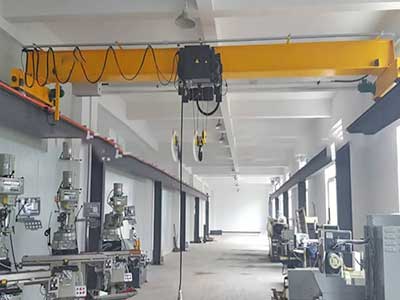
Top Running Design: In this configuration, the crane runs on rails mounted above the workshop floor. This setup allows for greater lifting heights, optimizing the use of vertical space and making it ideal for environments with high ceilings. The top-running design offers better clearance and is suited for applications where maximizing lifting height is critical.
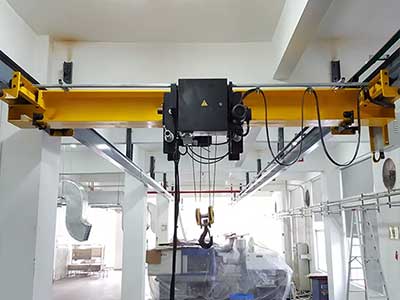
Underhung Design: Here, the crane operates on rails mounted beneath the ceiling, which is advantageous for facilities with lower ceiling heights or where vertical space is constrained. This design allows for efficient use of existing space and is particularly useful in environments where maintaining a clear and open workshop floor is important.
Applications
Single girder overhead cranes are versatile and widely employed across various functions in the automotive industry:
- Assembly Lines: These cranes are pivotal in assembly lines, where they handle components and materials efficiently. By positioning parts accurately along the production line, single girder cranes help maintain a smooth and continuous production flow, reducing downtime and increasing throughput.
- Parts Handling: During different stages of manufacturing, these cranes are used to lift and position vehicle parts and assemblies, such as engine components, chassis parts, and interior fittings. Their precision in handling these components ensures accurate assembly and minimizes handling errors.
- Maintenance and Repair: In maintenance bays, single girder cranes facilitate the handling of tools, equipment, and vehicle parts during servicing and repair operations. Their ability to move and position items easily helps in performing maintenance tasks efficiently and safely.
Overall, single girder overhead cranes offer an economical solution for handling lighter loads in automotive manufacturing and maintenance environments. Their simplicity, cost-effectiveness, and versatility make them a popular choice in the UK automotive industry, providing reliable performance across a range of applications.
Double Girder Overhead Cranes
Double girder overhead cranes are engineered for heavy-duty operations, offering enhanced stability, strength, and load-bearing capacity compared to their single girder counterparts. The design features two parallel beams, or girders, which support the crane's hoist and trolley. This dual-girder configuration not only provides greater structural integrity but also enables the crane to handle larger and heavier loads with ease.
Heavy-Duty Capabilities: The robust construction of double girder cranes is specifically designed to endure demanding operational environments. The two-girder setup distributes the weight more evenly, allowing the crane to support substantial loads and operate under rigorous conditions without compromising safety or performance.
Increased Load Capacity: By utilizing two girders, these cranes offer a superior load capacity, making them ideal for handling bulky and heavy components. This increased capacity enables the crane to lift and position large parts such as engine blocks, transmissions, and other significant automotive components efficiently and safely.
Applications
Double girder overhead cranes play a crucial role in several key areas of the automotive industry, where their robust design and high load capacity are essential:
- Heavy Component Handling: These cranes are indispensable for moving and positioning heavy vehicle components like engine blocks, transmissions, and large body panels. Their strength ensures that these substantial parts are handled securely, reducing the risk of damage and improving overall operational efficiency.
- Body Shop Operations: In body shops, double girder cranes facilitate the lifting and alignment of vehicle bodies and chassis. They support various operations, including welding, assembly, and painting. Their ability to handle large and heavy parts helps maintain precision and efficiency throughout the manufacturing process.
- Engine Assembly: During the assembly of engines, double girder cranes are used to lift and place heavy engine components. Their robust design allows for the accurate positioning of complex assemblies, ensuring that each part is correctly aligned and securely mounted.
Overall, double girder overhead cranes are vital for applications requiring high load capacities and durability. Their ability to manage heavy components and perform in demanding environments makes them an essential asset in the UK automotive industry. These cranes are particularly valuable in workshops and production lines where reliable and powerful material handling solutions are crucial for maintaining productivity and safety.
Jib Cranes: Pillar Jib Cranes and Wall-Mounted Jib Cranes
Jib cranes are celebrated for their flexibility and efficient use of space, making them ideal for specific applications within automotive manufacturing facilities. These cranes feature a horizontal jib (or arm) that extends from a vertical support structure, allowing them to lift and move materials within a defined radius. The two main types are:
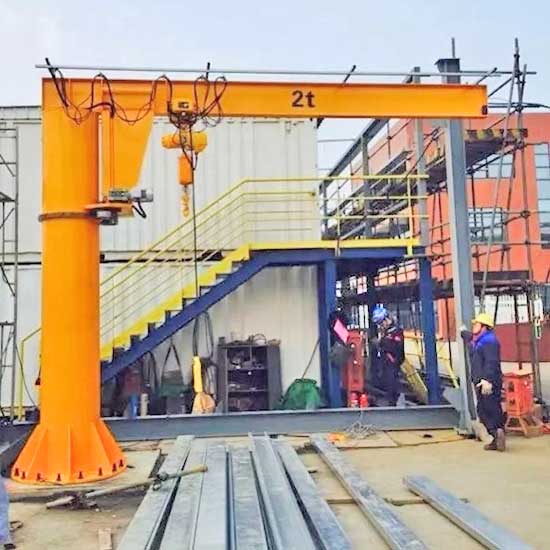
Pillar Jib Crane: This type is mounted on a fixed column or pillar, enabling the jib to rotate 360 degrees around its base. The pillar jib crane is suited for environments with ample vertical clearance, providing a broad range of movement within its operational radius. Its design allows for comprehensive coverage of the surrounding area, making it versatile for various tasks.
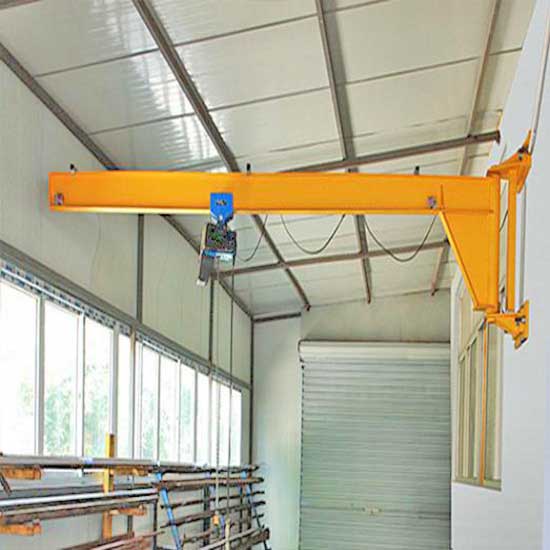
Wall-Mounted Jib Crane: Attached directly to a wall or vertical structure, the wall-mounted jib crane extends horizontally from the wall. This type offers a fixed radius of operation, making it ideal for locations where space is limited. By mounting to a wall, it conserves floor space while still providing effective material handling capabilities within its operational reach.
Flexible Reach: Jib cranes excel in providing a flexible reach within their operational radius. This flexibility allows for precise material handling in designated areas, making them particularly useful for tasks requiring careful placement and movement of components.
Space-Efficient: Jib cranes are designed to maximize vertical space and reduce floor obstruction. Their compact footprint is advantageous in confined or congested work environments, where floor space is at a premium.
Applications
Jib cranes are especially valuable in smaller or specialized areas within automotive manufacturing facilities due to their adaptability and space efficiency:
- Smaller Assembly Areas: In assembly stations with limited space, jib cranes are ideal for localized material handling. They enable the efficient movement of components and tools without consuming extensive floor area. This localized approach helps streamline assembly processes and enhances productivity in compact work environments.
- Localized Material Handling: Jib cranes are beneficial in environments where overhead space is restricted or where specific tasks require dedicated lifting solutions. They are particularly useful for tasks such as loading and unloading parts, supporting light assembly work, and managing tools and materials close to workstations. This localized handling improves workflow efficiency and reduces the need for extensive material transportation.
Overall, both pillar and wall-mounted jib cranes provide valuable flexibility and space efficiency in the UK automotive industry. Their ability to handle materials effectively in confined spaces and smaller assembly areas enhances productivity and optimizes workspace utilization, making them a key asset in automotive manufacturing facilities.
Gantry Cranes: Full Gantry & Semi Gantry Cranes
Gantry cranes are designed for versatility and robust performance, featuring a crane structure supported by two legs or beams that run on tracks or wheels. They are particularly effective in environments where high load capacities and extensive coverage are required. There are two primary types of gantry cranes:
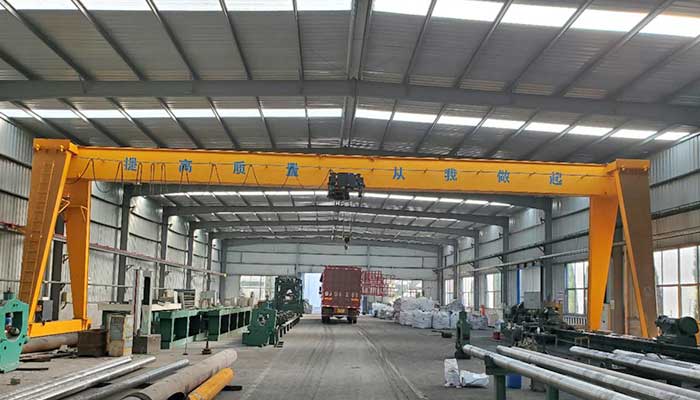
Full Gantry Crane with Single Girder Design : This type features a complete gantry structure with both legs running on tracks or wheels, allowing the crane to cover a large area and move freely within its operational zone. The full gantry configuration provides high stability and is capable of handling significant loads across its full span. Its ability to move across extensive tracks or wheels makes it suitable for operations requiring coverage of large work areas.
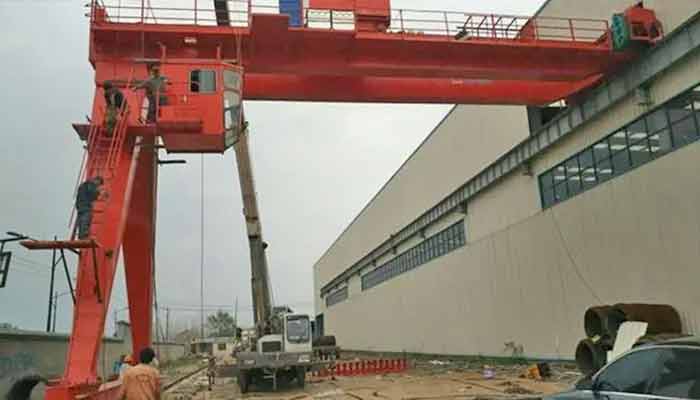
Semi Gantry Crane with Single Leg Design: Unlike the full gantry crane, the semi gantry crane has one support leg running on tracks, while the other end is supported by a fixed structure, such as a building column. This configuration allows for more flexible positioning and is often used in areas where space is constrained or where specific operational requirements demand a combination of fixed and mobile support.
Movable: Gantry cranes are equipped to move along their designated tracks or wheels, offering flexibility in material handling. This mobility enables coverage of large work areas and allows for efficient repositioning of the crane as needed.
High Load Capacity: Gantry cranes are built to handle heavy and oversized loads, making them suitable for demanding applications. Their design ensures that they can lift and transport substantial weights, which is essential for handling large components and equipment in automotive manufacturing and maintenance.
Applications
Gantry cranes play a crucial role in various critical areas within the automotive industry:
- Large Parts Handling: Gantry cranes are essential for lifting and moving large and heavy vehicle parts, such as chassis, body panels, and engine assemblies. Their high load capacity and wide span make them ideal for efficiently handling bulky components, which is vital in both production and maintenance settings.
- Maintenance Areas: In maintenance and repair workshops, gantry cranes facilitate the lifting and positioning of vehicles and heavy equipment for servicing. They provide the necessary reach and support for complex maintenance tasks, enabling technicians to perform repairs and upgrades with ease.
- Paint Shops: In automotive paint shops, gantry cranes are used to transport vehicle bodies through different stages of the painting process, including cleaning, priming, painting, and drying. Their ability to handle large items ensures smooth operation and consistent application of coatings, contributing to high-quality finishes.
Overall, full and semi gantry cranes are integral to operations that require substantial load capacities and movement flexibility. They enhance efficiency and safety in handling large parts and equipment, making them invaluable assets in automotive manufacturing, maintenance, and finishing operations across the UK. Their robust design and versatile capabilities support various tasks, ensuring that critical processes are carried out effectively and efficiently.
Applications of Overhead Cranes in Automotive Manufacturing UK
Assembly Lines
Role in Lifting and Positioning Components
- Overhead cranes play a critical role in automotive assembly lines by efficiently lifting and positioning various components throughout the production process. These cranes ensure that parts are accurately placed and aligned for assembly, which is essential for maintaining high production standards and minimizing errors.
- Component Handling: Overhead cranes handle everything from small, intricate parts to large assemblies, such as vehicle bodies and chassis. They transport components between different stages of the assembly line, facilitating smooth and uninterrupted workflow.
- Precision and Efficiency: By providing precise control over the lifting and placement of components, overhead cranes help in maintaining the accuracy of assembly operations. This precision is crucial for achieving high-quality finishes and ensuring that all parts fit together correctly.
Integration with Automated Systems
Overhead cranes in automotive manufacturing are often integrated with advanced automated systems to streamline production and enhance efficiency. This integration involves coordinating crane operations with other automation technologies, such as robotics and conveyor systems.
- Coordination with Robotics: In modern assembly lines, overhead cranes work alongside robotic arms and automated guided vehicles (AGVs) to handle and position components. This coordination allows for seamless transitions between different production stages and reduces the need for manual intervention.
- Integration with Conveyor Systems: Overhead cranes are often linked with conveyor belts that move components through various assembly stations. The cranes can lift and transfer components from the conveyor to the assembly stations and vice versa, ensuring a continuous and efficient flow of materials.
In the UK automotive manufacturing sector, the use of overhead cranes in assembly lines enhances productivity, accuracy, and flexibility. By integrating with automated systems, these cranes contribute to the overall efficiency and effectiveness of the production process, supporting the high standards and demands of the automotive industry.
Body Shop
In the body shop of automotive manufacturing facilities, overhead cranes are instrumental in managing the handling of vehicle chassis and large parts. These cranes support critical processes such as welding, alignment, and assembly operations. By lifting and positioning heavy and bulky vehicle components, overhead cranes facilitate precise and efficient workflow, essential for producing high-quality vehicles.
Overhead cranes in the body shop ensure that vehicle chassis and other large parts are accurately aligned and securely positioned for welding and assembly. This precision is crucial for maintaining the structural integrity and quality of the vehicle. The cranes' ability to handle heavy components with care helps streamline complex operations and reduces the risk of errors during the manufacturing process.
The integration of overhead cranes in body shop operations not only enhances efficiency but also supports the overall quality control and productivity of automotive manufacturing. By providing reliable handling and positioning capabilities, these cranes play a vital role in ensuring the smooth execution of body shop tasks and the successful assembly of vehicles.
Paint Shop
In the paint shop, overhead cranes are essential for the efficient movement of vehicles through various painting booths. These cranes handle the delicate task of transporting vehicles between different stages of the painting process, including cleaning, priming, painting, and drying. Their role ensures that each vehicle is properly processed and that the painting operations are executed smoothly.
Overhead cranes contribute to the precise and efficient handling of vehicles, which is crucial for achieving high-quality coatings. By lifting and positioning vehicles with care, these cranes help minimize the risk of damage during the painting process. This precision not only protects the vehicle's surface but also ensures that the paint application is even and consistent, leading to a high-quality finish.
Overall, the use of overhead cranes in the paint shop enhances the efficiency of the painting process, supports quality control, and helps maintain the high standards required in automotive manufacturing.
Engine and Transmission Assembly
In the engine and transmission assembly areas of automotive manufacturing, overhead cranes are crucial for handling heavy engine blocks and components. These cranes support both the assembly and disassembly of complex engine and transmission systems by providing the necessary lifting power and precision.
Overhead cranes facilitate the movement of large and heavy engine parts, ensuring that they are accurately positioned for assembly or disassembly. This support is essential for managing the intricate and often cumbersome components involved in engine and transmission assembly. By lifting and maneuvering these parts with care, cranes help streamline complex operations and reduce the physical strain on workers.
In addition to easing the handling of heavy components, overhead cranes contribute to overall efficiency in the assembly process. They enable smooth transitions between different stages of assembly, enhance workflow, and support the precise alignment of parts, ultimately leading to improved quality and reliability of the assembled engines and transmissions.
Testing and Quality Control
In the testing and quality control phases of automotive manufacturing, overhead cranes play a vital role in managing the movement and handling of vehicles during various tests. These cranes are essential for efficiently transporting vehicles to and from test rigs, where they undergo performance, safety, and durability evaluations.
Overhead cranes facilitate the precise placement of vehicles onto testing equipment, ensuring that they are accurately positioned for various assessments. This efficient transportation helps streamline the testing process, minimizing delays and enhancing the overall workflow.
In addition to supporting testing procedures, overhead cranes are crucial for inspection and maintenance tasks. They provide the necessary lifting and maneuvering capabilities to enable thorough inspection of vehicle components and systems. By assisting in the removal and replacement of parts, cranes help maintain the integrity of the testing equipment and support detailed quality control processes. This ensures that vehicles meet stringent quality standards before reaching the market.
Overhead Cranes in Related Parts Production Sectors
Metal Fabrication
In the metal fabrication sector, overhead cranes play a crucial role in managing the handling of metal sheets and components. These cranes are integral to various stages of metal processing, including cutting, welding, and finishing, providing essential support to ensure smooth and efficient operations.
Overhead cranes are used to lift and move large metal sheets, plates, and structural components throughout the fabrication process. Their ability to handle heavy and often unwieldy materials is vital for maintaining efficiency and safety in fabrication shops. Cranes facilitate the transportation of these materials from storage areas to cutting stations, welding bays, and finishing areas.
Integration with Cutting, Welding, and Finishing Processes:
- Cutting: In metal fabrication, cranes assist in the movement of metal sheets to cutting tables or laser cutting machines. They position materials accurately to ensure precision cuts, reducing waste and improving the quality of finished products. By handling large sheets or coils, cranes help streamline the cutting process and keep production lines running smoothly.
- Welding: During welding operations, overhead cranes move metal components into place for welding. They support the handling of large assemblies, such as frames or beams, ensuring they are correctly aligned for welding. This alignment is crucial for achieving strong, high-quality welds and maintaining structural integrity. Cranes also facilitate the transportation of welded assemblies to subsequent processing stages or storage.
- Finishing: After welding, metal components often require additional finishing processes such as grinding, painting, or coating. Overhead cranes transport these components to finishing stations, where they are handled carefully to avoid damage. By efficiently managing the movement of parts, cranes contribute to the smooth flow of work through the finishing process, ensuring that products meet the desired specifications and quality standards.
Overall, the integration of overhead cranes in metal fabrication enhances operational efficiency, supports high-quality production, and contributes to the overall productivity of the sector. Their ability to handle heavy and bulky materials with precision makes them indispensable in the metalworking industry.

Casting and Forging
In the casting and forging sectors, overhead cranes are essential for managing the movement and positioning of heavy castings and forgings. These cranes play a pivotal role in various stages of the casting and forging processes, particularly in handling the substantial weights and intricate movements required.
Moving and Positioning Heavy Castings and Forgings:
- Furnace Loading and Unloading: Overhead cranes are crucial for loading and unloading heavy metal castings and forgings into and out of furnaces. During the casting process, molten metal is poured into molds, and after cooling, the solidified castings need to be removed. Similarly, during forging, raw metal is heated to high temperatures before being forged into shape. Cranes handle these heavy and often extremely hot components, moving them safely and efficiently to and from the furnace or forging press.
- Positioning for Processing:After the initial heating or casting, metal parts often need to be repositioned for further processing, such as machining or quality inspection. Overhead cranes assist in accurately positioning these heavy parts on machining centers or inspection stations. This precision handling helps ensure that parts are correctly aligned for further operations, enhancing the accuracy and efficiency of the manufacturing process.
- Transporting to Storage or Shipping:Once casting and forging are complete, overhead cranes move the finished components to storage areas or prepare them for shipping. Cranes handle large and heavy parts with care, ensuring they are properly stored to prevent damage and facilitate easy access for subsequent processing or delivery.
In summary, overhead cranes are vital in the casting and forging industries for managing the heavy lifting and precise positioning required during various stages of production. Their ability to handle large and cumbersome components enhances operational efficiency, safety, and overall productivity in these sectors.
Machining
In the machining sector, overhead cranes are indispensable for managing large and heavy machine parts, ensuring efficient operation and enhanced productivity. They play a crucial role in various machining processes, including the handling of equipment and the loading and unloading of CNC machines.
- Support for Moving Large and Heavy Machine Parts:Overhead cranes are essential for lifting and moving substantial machine parts and components within machining facilities. These cranes facilitate the transportation of large and heavy items, such as machine bases, tables, and parts, from storage areas to the machining centers. Their capability to handle significant weights with precision ensures that large parts are moved safely and accurately, minimizing the risk of damage and enhancing the overall efficiency of the machining process.
- Efficient Handling of CNC Machines and Other Equipment:In facilities equipped with CNC (Computer Numerical Control) machines, overhead cranes are used to handle the machines themselves as well as the workpieces being processed. They assist in the positioning and alignment of CNC machines, ensuring that they are set up correctly for operations. Cranes also aid in moving heavy equipment components, such as spindles and tool changers, facilitating their installation and maintenance.
- Assistance in Loading and Unloading CNC Machines:Overhead cranes streamline the process of loading and unloading workpieces onto CNC machines. They efficiently handle the loading of large and heavy materials onto the machine beds, ensuring that components are positioned accurately for machining operations. This efficiency in handling not only improves the speed of production but also enhances the precision of machining tasks. By facilitating smooth and accurate loading and unloading, overhead cranes contribute to reduced setup times and increased overall machining productivity.
In summary, overhead cranes in the machining sector enhance the efficiency and safety of handling large and heavy machine parts. Their support in moving equipment and managing the loading and unloading of CNC machines plays a vital role in improving productivity and operational effectiveness in machining facilities.
Overhead Cranes in Automotive-Related Facilities Beyond Manufacturing Workshops
Automobile Testing Facilities
In automobile testing facilities, overhead cranes are integral for managing the logistics of vehicles and components throughout various testing phases. Their role extends beyond mere transportation; they play a critical part in ensuring the smooth operation and efficiency of the testing process.
Use: Moving Vehicles and Components Into and Out of Testing Areas
Overhead cranes are used to transport vehicles and automotive components into and out of specialized testing areas. This includes moving vehicles to different test stations where various performance, safety, and durability tests are conducted. The cranes handle the heavy lifting required to position vehicles and parts accurately, ensuring that they are correctly aligned and securely positioned for testing procedures.
Location: Vehicle Testing Laboratories and Test Tracks
These cranes are typically located in vehicle testing laboratories, where controlled environments are used to evaluate various aspects of vehicle performance, such as emissions, safety features, and handling characteristics. Additionally, they are found at test tracks, where real-world conditions are simulated to assess vehicle durability and reliability. The strategic placement of overhead cranes in these locations allows for efficient and effective handling of vehicles during the testing process.
How They Work: Lifting and Positioning Vehicles Onto Test Rigs or Transport to Different Testing Stations
Overhead cranes facilitate the lifting and precise positioning of vehicles onto test rigs or other specialized equipment used in the testing process. They are capable of moving vehicles from one station to another within the testing facility, ensuring that vehicles and components are correctly placed for each specific test. This functionality helps maintain the flow of operations, reduces the risk of damage during handling, and supports the efficient execution of testing procedures.
In summary, overhead cranes in automobile testing facilities are essential for the efficient movement and positioning of vehicles and components. Their role in lifting and transporting items to various test stations ensures that testing processes are conducted smoothly and accurately, contributing to the overall effectiveness and efficiency of vehicle evaluation.
Automotive Research and Development (R&D) Centers
In automotive research and development (R&D) centers, overhead cranes are crucial for managing the logistics of prototypes, experimental components, and specialized test equipment. These cranes support the innovative processes essential for developing new vehicle models and technologies.
Use: Moving Prototypes, Experimental Components, and Test Equipment
Overhead cranes in R&D centers handle a variety of tasks, including the transportation of prototypes, experimental components, and test equipment. They are used to move delicate prototype parts that may be complex or require careful handling. Additionally, these cranes facilitate the relocation of heavy or bulky test equipment that is essential for conducting experiments and evaluations.
Location: R&D Laboratories and Prototype Assembly Areas
These cranes are typically found in R&D laboratories and prototype assembly areas. R&D laboratories are dedicated to testing and experimenting with new technologies and vehicle components, while prototype assembly areas focus on building and refining new vehicle prototypes. The strategic placement of overhead cranes in these areas ensures that components and prototypes can be efficiently managed and transported throughout the development process.
How They Work: Facilitating Handling of Delicate or Heavy Prototype Parts for New Model Development
Overhead cranes in R&D centers are designed to handle both delicate and heavy prototype parts with precision. They are equipped to lift and move components without causing damage, which is essential when dealing with experimental parts that may be sensitive or require careful handling. These cranes also support the assembly and disassembly of prototypes, aiding engineers and researchers in the iterative process of model development and refinement.
In summary, overhead cranes in automotive R&D centers play a vital role in facilitating the movement and handling of prototypes, experimental components, and test equipment. Their ability to manage delicate and heavy parts with precision supports the development of new vehicle models and technologies, contributing to innovation and advancement in the automotive industry.
Automotive Recycling and Dismantling
In automotive recycling and dismantling facilities, overhead cranes play a pivotal role in managing the end-of-life vehicles and components that are processed for recycling. These cranes are essential for handling large and heavy parts that need to be sorted and processed efficiently.
Use: Handling End-of-Life Vehicles and Components for Recycling
Overhead cranes are utilized to handle vehicles and parts that have reached the end of their lifecycle. They manage the transportation of these vehicles and components from one area to another within the recycling facility. This includes moving entire vehicles to dismantling stations and handling large components, such as engines and transmissions, for further processing.
Location: Automotive Recycling Centers and Dismantling Yards
These cranes are strategically placed in automotive recycling centers and dismantling yards. Recycling centers focus on the processing and recycling of automotive materials, while dismantling yards are dedicated to disassembling vehicles and sorting their parts for reuse or disposal. The cranes' placement in these areas ensures efficient material flow and operational productivity.
How They Work: Lifting and Moving Dismantled Parts and Scrap Materials for Sorting and Processing
Overhead cranes in recycling and dismantling facilities are equipped to lift and move dismantled parts and scrap materials. They assist in transferring parts from dismantling stations to sorting areas, where materials are categorized based on type and potential for recycling. The cranes also handle bulk scrap materials, facilitating their movement to processing equipment or storage areas. By efficiently managing these tasks, overhead cranes contribute to streamlined operations and effective recycling processes.
In summary, overhead cranes in automotive recycling and dismantling facilities are vital for handling end-of-life vehicles and components. They enable efficient movement and processing of dismantled parts and scrap materials, supporting effective recycling and contributing to environmental sustainability in the automotive industry.

Automotive Parts Manufacturing
In automotive parts manufacturing, overhead cranes are crucial for managing heavy tools and components throughout the production process. These cranes support various tasks, from moving large molds to transporting finished parts, ensuring smooth and efficient manufacturing operations.
Use: Handling Heavy Molds, Dies, and Large Production Equipment
Overhead cranes are employed to handle substantial equipment such as molds and dies, which are essential for producing automotive parts. These cranes are also used to move large production machinery, such as presses and injection molding machines, that are integral to the manufacturing process. By managing these heavy items, overhead cranes help maintain a steady workflow and prevent operational delays.
Location: Parts Manufacturing Plants and Foundries
These cranes are located in parts manufacturing plants and foundries, where automotive components are produced. Manufacturing plants focus on creating a wide range of parts, from engine components to chassis parts, while foundries are specialized in casting metal parts. In both environments, overhead cranes facilitate the movement of tools and equipment within the production area.
How They Work: Moving Large Tools, Machinery, and Finished Parts to and from Production Lines
Overhead cranes in automotive parts manufacturing are designed to efficiently move large tools and machinery between different areas of the production line. They lift and transport heavy molds and dies to the injection molding machines or casting stations, and they also handle the transportation of finished parts to assembly or storage areas. This handling process reduces manual labor and enhances overall production efficiency by ensuring that all necessary equipment and components are readily available at each stage of manufacturing.
In summary, overhead cranes in automotive parts manufacturing are indispensable for managing heavy equipment and components. They ensure efficient handling of molds, dies, and machinery, supporting a smooth and effective manufacturing process while maintaining high productivity levels.
Automobile Dealerships and Service Centers
In automobile dealerships and service centers, overhead cranes play a key role in facilitating vehicle maintenance and repair operations. These cranes are essential for efficiently handling and lifting vehicles, particularly in high-volume service environments where quick turnaround times are crucial.
Use: Handling and Lifting Vehicles During Maintenance or Repairs
Overhead cranes in dealerships and service centers are used to lift vehicles during various maintenance and repair tasks. They assist in elevating vehicles to provide access to the underside for routine inspections, repairs, and component replacements. This capability is particularly important for performing tasks such as oil changes, brake repairs, and transmission work.
Location: Large Service Bays or Specialized Maintenance Areas Within Dealerships
These cranes are typically found in large service bays or specialized maintenance areas within automobile dealerships. Service bays are designed to accommodate multiple vehicles simultaneously, and the cranes are strategically positioned to maximize accessibility and efficiency. Specialized maintenance areas are equipped to handle specific types of repairs or services, and the cranes support these specialized tasks by providing the necessary lifting and handling capabilities.
How They Work: Lifting Vehicles for Service, Repair, or Inspection in High-Volume Service Centers
In high-volume service centers, overhead cranes efficiently lift vehicles to ensure that maintenance and repair work is completed quickly and effectively. The cranes are used to elevate vehicles into the optimal position for mechanics to perform their tasks. By streamlining the process of lifting and lowering vehicles, these cranes help reduce the time required for each service job and improve overall operational efficiency. The use of overhead cranes minimizes the need for manual lifting and enhances the safety and convenience of vehicle maintenance procedures.
Overall, overhead cranes in automobile dealerships and service centers are vital for handling and lifting vehicles during maintenance and repairs. They ensure that service operations are conducted smoothly and efficiently, supporting high levels of productivity and customer satisfaction in automotive service environments.
Automotive Parts Warehouses
In automotive parts warehouses, overhead cranes are crucial for the efficient storage and management of automotive parts and accessories. These cranes streamline the handling of large volumes of parts, which is essential for maintaining smooth operations in distribution centers and warehouses.
Use: Storing and Managing Automotive Parts and Accessories
Overhead cranes in parts warehouses are used to handle a wide range of automotive components and accessories. They are designed to move heavy pallets of parts, facilitating their transport to and from storage areas. This capability is crucial for ensuring that parts are readily available for distribution and reducing the risk of damage during handling.
Location: Distribution Centers and Parts Warehouses
These cranes are typically located in distribution centers and large parts warehouses where automotive parts are stored before being shipped to dealerships or repair facilities. Distribution centers serve as central hubs for managing inventory and coordinating the flow of parts to various locations. Parts warehouses, on the other hand, are specialized facilities dedicated to storing and organizing a wide range of automotive components.
How They Work: Moving Heavy Pallets of Parts, Managing Inventory, and Handling Bulk Storage Operations
In automotive parts warehouses, overhead cranes efficiently move heavy pallets of parts throughout the facility. They are used to transfer pallets from receiving areas to storage racks and from storage racks to shipping areas. This capability is essential for managing inventory and ensuring that parts are stored in an organized manner. The cranes also assist in handling bulk storage operations, making it easier to retrieve and transport large quantities of parts as needed.
Overall, overhead cranes in automotive parts warehouses play a vital role in the efficient storage and management of automotive components. They help optimize warehouse operations by improving inventory management, reducing handling times, and supporting bulk storage and retrieval processes.
Assembly Line Maintenance
In automotive manufacturing, overhead cranes play a crucial role in maintaining and repairing assembly line equipment. These cranes are essential for ensuring the smooth operation of production lines by minimizing downtime and facilitating quick repairs.
Use: Performing Maintenance and Repairs on Assembly Line Equipment
Overhead cranes are used to perform maintenance and repairs on various components of assembly line equipment. This includes lifting and replacing heavy parts such as motors, conveyor sections, and other machinery components that are integral to the assembly process. By using overhead cranes, maintenance teams can efficiently access and work on equipment without the need for extensive disassembly or disruption of the production line.
Location: Above or Near Assembly Lines and Production Equipment
These cranes are typically installed above or near the assembly lines and production equipment. Their positioning allows for easy access to machinery and components that need to be serviced. In many manufacturing facilities, cranes are strategically placed to ensure they can reach various parts of the assembly line and provide support where it is most needed.
How They Work: Lifting and Replacing Large Components to Ensure Minimal Downtime
Overhead cranes in assembly line maintenance facilities are designed to lift and replace large components with precision and ease. They enable maintenance crews to quickly move and position heavy parts, reducing the time required for repairs and minimizing the impact on production schedules. By efficiently handling large components, these cranes help ensure that assembly lines experience minimal downtime, which is critical for maintaining production efficiency and meeting manufacturing targets.
Overall, overhead cranes are vital in assembly line maintenance, as they support the efficient repair and upkeep of production equipment. Their ability to handle heavy components and operate in close proximity to assembly lines helps keep manufacturing processes running smoothly and reduces potential interruptions in production.
Logistics and Shipping
In the automotive industry, overhead cranes are pivotal in the logistics and shipping processes, ensuring that parts and vehicles are efficiently prepared for distribution.
Use: Preparing Automotive Parts for Shipment and Handling Bulk Cargo
Overhead cranes are employed to prepare automotive parts for shipment and manage bulk cargo efficiently. They play a crucial role in moving and organizing parts, assemblies, and completed vehicles as they transition from the production phase to shipping. This includes the handling of heavy or oversized items that require precise and careful movement.
Location: Shipping and Logistics Centers Associated with Automotive Manufacturers
These cranes are commonly found in shipping and logistics centers that are closely linked to automotive manufacturers. Located near or within distribution hubs, these centers are designed to handle large volumes of parts and vehicles that need to be shipped to various destinations. Overhead cranes are essential in these locations to manage the logistics of moving goods from production to distribution networks.
How They Work: Loading and Unloading Parts and Vehicles from Containers, Trucks, or Railcars
Overhead cranes facilitate the loading and unloading of parts and vehicles from containers, trucks, or railcars. They are used to lift and position items into shipping containers or onto transport vehicles, ensuring that products are securely and efficiently loaded. Additionally, cranes are employed to offload incoming shipments and handle bulk cargo, making it easier to manage large quantities of goods and streamline the shipping process. By automating these tasks, overhead cranes help optimize the logistics operations, reduce handling time, and enhance overall efficiency in the distribution of automotive products.
Automotive Paint Shops
Overhead cranes play a critical role in the automotive paint shops, where they manage the complex processes involved in painting vehicle bodies.
Use: Managing the Movement of Vehicle Bodies Through Painting Processes
In automotive paint shops, overhead cranes are essential for managing the movement of vehicle bodies through various stages of the painting process. This includes transporting vehicles through cleaning, priming, painting, and drying stations. The cranes help streamline these processes by ensuring that vehicle bodies are moved efficiently and safely from one stage to the next.
Location: Automotive Paint Shops
These cranes are located in automotive paint shops, which are specialized facilities dedicated to applying finishes to vehicle bodies. Paint shops are crucial in the automotive manufacturing process, where high-quality paint and coatings are applied to vehicles. The overhead cranes in these environments need to be robust and precise to handle the delicate and often heavy vehicle bodies without causing damage.
How They Work: Transporting Vehicle Bodies Through Cleaning, Priming, Painting, and Drying Stations
Overhead cranes transport vehicle bodies through the various stages of the painting process. Initially, they move vehicles to cleaning stations to prepare surfaces for painting. Next, the cranes transport the vehicles to priming stations, where a base layer is applied. Following priming, the vehicles are moved to painting booths where the final color coats are applied. Finally, the cranes help transport the painted vehicles to drying stations, ensuring that each stage of the process is completed smoothly and efficiently. By automating the movement of vehicle bodies, overhead cranes contribute to a more organized and high-quality painting process, reducing the risk of defects and ensuring consistent application of coatings.
Automotive Accessory Installation
Overhead cranes are integral to automotive accessory installation, where they facilitate the addition of various components to vehicles.
Use: Installing Large Accessories or Optional Components onto Vehicles
In automotive accessory installation departments, overhead cranes are employed to assist in fitting large accessories or optional components onto vehicles. This includes items such as roof racks, spoilers, and other aftermarket parts that enhance vehicle functionality or aesthetics. By handling these bulky and sometimes cumbersome accessories, overhead cranes make the installation process more efficient and accurate.
Location: Accessory Installation Departments or Aftermarket Accessory Centers
These cranes are located in specialized accessory installation departments within automotive manufacturing facilities or in dedicated aftermarket accessory centers. These areas focus on adding extra features to vehicles either during the initial production phase or as part of post-production customization. The cranes are essential in these settings for managing the installation of heavy or awkward components without causing damage to the vehicles or the accessories themselves.
How They Work: Handling and Positioning Large Accessories Such as Roof Racks and Spoilers
Overhead cranes in accessory installation areas are designed to handle and position large accessories with precision. They lift and maneuver components like roof racks and spoilers into place, ensuring they are correctly aligned and securely attached to the vehicle. The cranes' ability to provide accurate and controlled movement helps in avoiding misalignment and reduces the risk of damaging both the vehicle and the accessory. This streamlined approach ensures that the installation is performed efficiently and meets high-quality standards.
Benefits of Overhead Cranes in the Automotive Industry
Efficiency and Productivity
Overhead cranes play a critical role in enhancing both efficiency and productivity within the automotive industry. They offer several advantages that streamline operations and improve overall performance:
- Reduction in Manual Labor: By automating the lifting and transportation of heavy and bulky items, overhead cranes significantly reduce the need for manual handling. This not only alleviates physical strain on workers but also minimizes the risk of injuries associated with manual lifting. As a result, labor resources can be redirected toward more skilled tasks, increasing the overall efficiency of the production process.
- Increased Speed of Material Handling: Overhead cranes accelerate the movement of materials and components throughout the manufacturing process. Their ability to lift, move, and position heavy parts quickly and precisely helps to maintain a smooth and continuous flow of production. This speed contributes to faster turnaround times, allowing manufacturers to meet tight production schedules and respond promptly to market demands.
Overall, the integration of overhead cranes in automotive manufacturing not only enhances operational efficiency but also supports higher productivity levels, enabling manufacturers to maintain a competitive edge in the industry.
Safety
The implementation of overhead cranes in automotive manufacturing facilities significantly contributes to workplace safety in several key ways:
- Minimization of Workplace Accidents: Overhead cranes are designed to handle heavy and bulky materials, which reduces the need for manual lifting and handling by workers. By automating these tasks, the risk of musculoskeletal injuries, strains, and other lifting-related accidents is greatly diminished. The use of overhead cranes also decreases the likelihood of accidents caused by dropped or mishandled parts, creating a safer work environment for employees.
- Enhanced Control Over Heavy Lifting Operations: Overhead cranes provide precise control over the movement and positioning of heavy components. Operators can carefully lift, maneuver, and place materials with high accuracy, reducing the chances of errors or accidents. Advanced features such as load sensors, safety interlocks, and remote controls further enhance operational safety by ensuring that cranes operate within safe parameters and reducing the potential for human error.
By improving safety standards, overhead cranes not only protect workers but also contribute to a more efficient and reliable manufacturing process, leading to overall better operational outcomes.
Flexibility
Overhead cranes offer significant flexibility, enhancing their utility across various manufacturing processes and tasks:
- Adaptability to Various Manufacturing Processes: Overhead cranes are versatile and can be tailored to fit different production environments and workflows. Whether it's for assembly lines, body shops, or paint shops, these cranes can be adjusted to handle a range of materials and components. Their ability to integrate with automated systems, such as conveyor belts and robotic arms, further increases their adaptability, allowing them to meet the specific needs of different production stages and processes.
- Customization for Specific Tasks and Components: Overhead cranes can be customized to handle unique tasks and specific components in the automotive industry. This includes configuring cranes with specialized hooks, grabs, or other attachments designed for particular parts, such as engine blocks, chassis, or large panels. Customization also extends to the crane's size, lifting capacity, and control systems, enabling it to handle specific loads efficiently and effectively. This level of customization ensures that overhead cranes can be optimized for both general and specialized tasks, providing a tailored solution for varied manufacturing needs.
Overall, the flexibility of overhead cranes enhances their effectiveness in diverse automotive manufacturing environments, supporting a range of tasks from routine handling to specialized operations.
Space Utilization
Overhead cranes significantly contribute to optimizing space in automotive manufacturing facilities, enhancing overall operational efficiency:
- Optimization of Workspace Layout: Overhead cranes help streamline workspace layout by minimizing the need for extensive floor space. Their ability to move along fixed tracks or rails means that valuable floor space can be kept clear of obstacles, enabling more efficient organization of workstations and equipment. This vertical movement reduces clutter and allows for more effective use of floor areas, facilitating smoother workflows and better organization within manufacturing and assembly areas.
- Efficient Use of Vertical Space: By operating above the production floor, overhead cranes make full use of vertical space. This is particularly beneficial in facilities with limited floor area. Cranes can lift and store materials, components, and finished products at different heights, freeing up ground space for additional workstations or storage areas. This vertical efficiency maximizes the available space and enhances the overall functionality of the facility, making it possible to handle larger volumes of materials and products without compromising on floor space.
In summary, overhead cranes play a crucial role in optimizing space within automotive manufacturing environments by improving workspace layout and making efficient use of vertical space.
Challenges and Considerations
Maintenance and Upkeep
Maintaining overhead cranes in the automotive industry is crucial for ensuring operational efficiency and safety. Here are some key considerations:
- Regular Inspection and Servicing Requirements: Overhead cranes require routine inspections and servicing to maintain optimal performance and safety standards. Regular checks help identify potential issues before they escalate into major problems, ensuring that the equipment operates smoothly. Maintenance tasks often include inspecting critical components such as hoists, motors, brakes, and control systems, as well as lubricating moving parts and verifying alignment. Scheduled maintenance plans should adhere to manufacturer guidelines and industry regulations to prevent unexpected downtime and costly repairs.
- Addressing Wear and Tear: Over time, overhead cranes experience wear and tear due to constant use and exposure to various operational stresses. Addressing these issues promptly is essential to prevent equipment failure and maintain safety. Common areas that may require attention include cables, pulleys, and structural components. Regular maintenance schedules should include thorough inspections to detect signs of wear, such as frayed cables or worn bearings, and take corrective action to repair or replace damaged parts. Implementing a proactive maintenance strategy helps extend the lifespan of the cranes and ensures continuous, reliable operation in demanding automotive environments.
In summary, effective maintenance and upkeep of overhead cranes involve regular inspections, servicing, and prompt attention to wear and tear. Properly managing these aspects helps maintain operational efficiency, safety, and longevity of the equipment.
Regulatory Compliance
Adherence to Safety Standards and Regulations
In the automotive industry, regulatory compliance is essential for ensuring the safety and efficiency of overhead cranes. This involves adhering to a range of safety standards and regulations designed to protect workers and maintain operational integrity. Key aspects of regulatory compliance include:
- Adherence to Safety Standards: Overhead cranes must comply with national and international safety standards to ensure they operate safely and effectively. In the UK, this includes compliance with the Health and Safety Executive (HSE) regulations and British Standards such as BS 7671 for electrical installations and BS EN 15011 for crane design and safety. These standards cover various aspects, including load capacities, operational procedures, and emergency protocols, and are designed to minimize risks associated with crane operations.
- Regular Safety Audits and Inspections: To maintain compliance, regular safety audits and inspections are required. These audits assess whether cranes meet the necessary safety standards and identify areas for improvement. Regular inspections should be conducted by qualified personnel to ensure all components and systems are functioning correctly and to address any safety concerns promptly. Documentation of these inspections is crucial for regulatory compliance and for demonstrating adherence to safety standards.
Ensuring Compliance with Industry-Specific Requirements
In addition to general safety standards, overhead cranes used in the automotive industry must meet industry-specific requirements to address the unique challenges and conditions of automotive manufacturing. This includes:
- Compliance with Industry-Specific Regulations: Automotive manufacturers must ensure their cranes comply with regulations specific to the automotive sector. This might involve additional safety measures, such as explosion-proof features for handling flammable materials or enhanced precision for handling delicate components. Understanding and implementing these industry-specific requirements helps ensure cranes operate effectively within the automotive environment.
- Documentation and Certification: Maintaining proper documentation and certification is crucial for regulatory compliance. This includes keeping records of inspections, maintenance, and safety audits, as well as certifications from relevant authorities. Proper documentation helps demonstrate adherence to regulations and can be essential in case of audits or investigations.
In summary, regulatory compliance for overhead cranes involves strict adherence to safety standards and industry-specific regulations, regular safety audits, and maintaining comprehensive documentation. Ensuring compliance helps protect workers, enhance operational efficiency, and maintain the overall safety and reliability of crane operations in the automotive industry.
Integration with Automation
Compatibility with Automated Systems and Robotics
In modern automotive manufacturing, the integration of overhead cranes with automated systems and robotics is crucial for enhancing operational efficiency and precision. Overhead cranes must be compatible with various automated systems to seamlessly coordinate material handling and production processes. Key aspects include:
- Synchronization with Automated Systems: Overhead cranes need to be synchronized with automated systems such as conveyor belts, robotic arms, and automated guided vehicles (AGVs). This synchronization ensures that material handling tasks, such as moving parts between workstations or transporting components to and from assembly lines, are performed smoothly and efficiently. Advanced control systems and communication protocols are employed to facilitate this integration, allowing cranes to operate in harmony with other automated equipment.
- Integration with Robotics: In many automotive manufacturing facilities, robotics play a significant role in tasks such as welding, painting, and assembly. Overhead cranes must be integrated with these robotic systems to provide precise and timely material handling. This involves coordinating crane movements with robotic operations, ensuring that components are delivered to the exact location needed for robotic tasks. Integration often requires advanced programming and control systems to manage the interactions between cranes and robots effectively.
Challenges in Integrating with Existing Infrastructure
Integrating overhead cranes with existing infrastructure and automated systems presents several challenges:
- Compatibility Issues: Existing infrastructure may not always be compatible with new automated systems or advanced crane technologies. This can include differences in control systems, communication protocols, or physical constraints in the facility layout. Addressing these compatibility issues may require modifications to existing equipment, additional interfaces, or updates to control software to ensure seamless integration.
- Infrastructure Adaptations: Integrating new overhead cranes with existing infrastructure often necessitates adaptations to the facility layout or infrastructure. For example, existing crane tracks or support structures may need to be adjusted or reinforced to accommodate new cranes with different specifications or features. Additionally, coordination between different systems (e.g., conveyors, robots, cranes) requires careful planning and design to avoid operational conflicts and ensure efficient workflows.
- Programming and Control: Effective integration requires sophisticated programming and control systems to manage the interactions between cranes and other automated equipment. This includes developing and testing control algorithms to ensure that cranes and automated systems operate in sync, handle materials accurately, and adapt to changes in production schedules or tasks.
- Training and Adaptation: Staff training is essential to manage and operate integrated systems effectively. Operators, maintenance personnel, and system administrators need to be trained on the new technologies, control systems, and integration processes to ensure smooth operation and maintenance of the integrated systems.
In summary, integrating overhead cranes with automated systems and robotics involves ensuring compatibility with existing infrastructure, addressing integration challenges, and implementing effective control systems. By overcoming these challenges, manufacturers can enhance efficiency, precision, and flexibility in their production processes.
Conclusion
Recap of the Importance of Overhead Cranes in the Automotive Industry
Overhead cranes play a pivotal role in the automotive industry by facilitating the efficient and precise handling of materials and components throughout various manufacturing processes. From the assembly lines to the paint shops and engine assembly areas, these cranes are indispensable for lifting, moving, and positioning heavy and delicate parts with ease. They contribute significantly to maintaining streamlined operations and ensuring that production lines run smoothly, which is essential for meeting the high demands and stringent quality standards of the automotive sector.
Summary of Key Benefits and Applications
The benefits of overhead cranes in the automotive industry are manifold:
- Efficiency and Productivity: By automating material handling, overhead cranes reduce manual labor and speed up production processes. This leads to higher throughput and more efficient use of resources.
- Safety: Overhead cranes enhance workplace safety by minimizing the risks associated with manual lifting and handling. They provide better control over heavy loads, reducing the likelihood of accidents and injuries.
- Flexibility: Overhead cranes are highly adaptable to various manufacturing processes and can be customized to handle specific tasks and components. This flexibility allows automotive manufacturers to respond quickly to changes in production needs and requirements.
- Space Utilization: These cranes optimize workspace layout by making efficient use of vertical space. This helps in managing floor space effectively and accommodates more production activities within the same facility.
Future Outlook for Crane Technology and Its Impact on the Industry
The future of crane technology in the automotive industry promises exciting developments:
- Advanced Crane Technologies: Innovations such as smart cranes equipped with IoT capabilities and advanced control systems are expected to enhance automation, precision, and operational efficiency. These technologies will enable real-time monitoring, predictive maintenance, and seamless integration with other automated systems.
- Sustainability: There is a growing emphasis on reducing the environmental impact of manufacturing processes. Future crane technologies will likely incorporate energy-efficient designs, sustainable materials, and practices that align with broader environmental goals.
- Customization and Specialization: As the automotive industry continues to evolve, there will be an increasing demand for customized crane solutions tailored to specific manufacturing needs. Innovations in crane design and functionality will focus on meeting the unique requirements of different automotive applications, further enhancing performance and efficiency.
Overall, the advancement in overhead crane technology will continue to shape the future of automotive manufacturing, driving improvements in productivity, safety, and sustainability. By staying ahead of these trends, the industry can ensure that its manufacturing processes remain cutting-edge and capable of meeting the demands of an ever-evolving market. Contact us to get your custom crane for automobile industrial sectors. Contact us today to check what we can do to save your cost.
Related Products
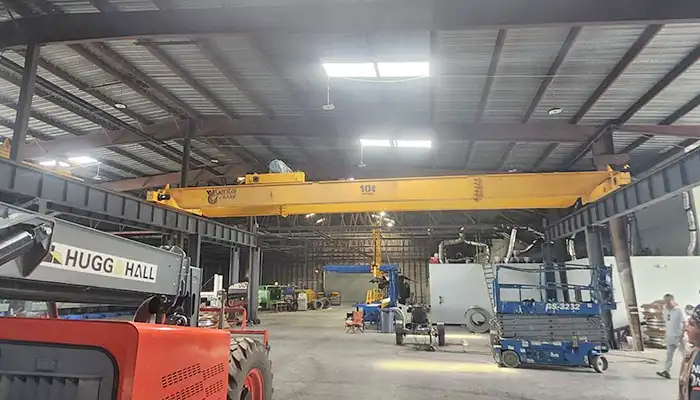
Affordable 10 ton double girder overhead crane with CD/MD hoist trolley, built for U.S. standards, ideal for construction and industrial lifting
Free consultation to Confirm Parameters & Specifications and Get
Latest Crane Price & Crane Rate.
- Types of overhead cranes : _______?
- Optional: Overhead travelling crane, goliath gantry crane,Slewing jib crane, Single girder or double girder crane,small portable crane or kbk crane, etc.
- Capacity of overhead crane: _______?
- Optional: 0.25ton, 0.5 ton, 1 ton, 2 ton, 3ton, 5 ton, 10 ton,15ton, 20ton, 25 ton, 30ton,35ton, up to 550ton, etc.
- Crane span & lifting height : _______?
- Crane travelling length : _____?
- Control of overhead crane:_______?
- Optional: pendant/ remote/cabin control
- Voltage supply of overhead crane:_____?
- Eg,: 380V50/60HZ,3Phase or others,etc.
- Application/usage of crane:_______?
- Eg,: Steel mill, ,injection mold, cement,stone, concrete,granite, general manufacturing, etc.
Just leave a message via the contact form and our hoist and crane engineer will contact you with in 24working hours.
Get In Touch
